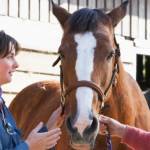Locating the Site of a Horse’s Lameness

When examining the lame horse, care must be taken to avoid causing further pain and harm. First, look for obvious signs while the horse is at rest. Does the horse appear to be favoring a leg? It is normal for a horse to rest a hind leg; however, it should willingly take weight on the rested leg. It is not normal for a horse to rest a front leg.
If the lame leg is not apparent, pick up and pick out all the feet. Inspect the legs and feet for signs of injury such as bleeding, swelling, heat, or a bounding pulse. Check to see if the horse is unwilling to put full weight on a limb when the opposite foot is picked up. Look for objects such as stones, nails, or wire that may have caused injury to the foot.
Further investigation can involve having the horse led at a trot on a hard, level surface. The horse should be trotted away from, towards, and past the observer. It is vital that the horse trots on a loose rein so its head is free to move up and down. If the horse is lame in a front leg, the head goes up when the lame leg hits the ground (as the horse attempts to put as little weight as possible on that leg), and the head goes down when the good leg takes weight. If the horse is sore in both front legs it will have a stiff, choppy action. Sometimes longeing a horse will demonstrate lameness that is not evident when moving in a straight line, and working on a soft rather than a hard surface may reveal different degrees of lameness.
Hind limb lameness is harder to detect than forelimb lameness because the head nodding may not be as obvious. The horse may nod its head down when taking weight on the sore hind limb. From the side view, short stepping in the lame leg may be seen; from behind, the hindquarter on the side of the lame leg may rise higher than the other side (again, as the horse attempts to put less weight on the painful leg).
Once the lame leg has been identified, recheck for heat in the leg and foot; swelling; a strong digital pulse; pain when a joint is palpated or flexed.
Determining exactly where the problem is once the lame leg has been identified can take a lot of skill, and usually a veterinary examination is required. This may involve a number of diagnostic procedures or tests such as:
- a flexion test in which the leg is held in a flexed position for one minute and the horse is then immediately trotted out by a handler; the vet will watch for lameness in the first steps taken after release;
- hoof test using hoof testers;
- diagnostic imaging using ultrasound, thermography, radiography, and/or scintigraphy;
- nerve blocks
The history of the horse is important for making a diagnosis. Keeping a record of the following factors will be helpful for the vet.
• Has the horse been lame in the past?
• When was the horse last shod, and does the horse have any abnormal shoe wear?
• Have there been any recent changes in the management of the horse?
• Does the lameness increase when the horse is ridden?
• Does the lameness disappear/change with exercise?
• How old is the horse?
• What type of work is the horse doing now?
• Is the horse stumbling?
• Is the horse undergoing any treatments?
• What surface does the horse usually work on?
Once the exact site and possible cause of the lameness have been determined, a proper course of treatment can be prescribed.








